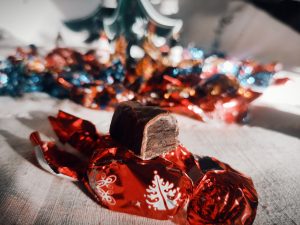
A new addition, szaloncukor, is an indispensable part of Christmas in Hungary.Continue reading

One of Hungarians’ favorite Christmas sweets, Szaloncukor (usually made of fondant, covered by chocolate), that has just this year been selected for the Hungarikum collection, is a highlight on every family’s Christmas tree every year. If you come across this Hungarian delicacy anywhere in the world, it is most likely to have been made in Hungary.
However, fondant sugar – a sugar paste crystallized from a supersaturated solution – that is the ancestor and basis of all szaloncukors, originated in France, writes history portal mult-kor.hu. The ancestor of szaloncukor emerged during the 14th century in France. According to some sources, it was in Berlin in the 17th century that a French confectioner who had settled there introduced this fondant dessert to a wider public. According to other theories, the 16th century confectioners who arrived in Hungary with the Turks already had fondant-like sweets flavored with fruit.

Ungarn Heute
Hungarian confectioners began to make these sweets in the first third of the 19th century. In the second half of the century, it was already a sought-after Christmas seasonal product in the Hungarian confectionery industry.
The candy, which can be hung on a tree and is wrapped in paper and glittering tin foil, has been made exclusively by Hungarians ever since.
In those days, fondant was cooked in pots on open fires in small-scale factories, by hand. It was cooled, then reheated, flavored, molded, and packaged. The first fondant-making machines were used by Stühmer chocolate factory and the Gerbeaud confectionery at the end of the 19th century.

Photo: Hungary Today
Thereafter, all the operations involved in the production of fondant were gradually mechanized. For the longest time, manual work in packaging was preserved. In many small workshops, these decorative sweets were still packaged by hand after the Second World War.
Nowadays, as Christmas approaches, various confectioners produce a flood of szaloncukors: in a wide variety of flavors and coatings, in many different wrappings, for the enjoyment of children and adults alike, and of course to decorate Christmas trees.

Photo: Hungary Today
This year, for the fifth time, the “Szaloncukor of the Year” competition was held, with a number of Hungarian confectioners and manufacturers competing for the title of best szaloncukor.
Every year, Stühmer’s caramelized white chocolate covered pear jelly-muskat product has moved up one step on the imaginary podium, and this year it has already won the “Szaloncukor of the Year” award. The runner-up was Gyulai Kézműves Confectionery’s Bailey’s coffee flavored sweet and the third place went to a dessert with surprisingly paired flavor, Sulyán Confectionery’s peanut butter and chips flavored szaloncukor.
Although nowadays most candies are made in factories, the popularity of artisan products is growing. Pastry chef Jenő Vadócz recently told zaol.hu that Promenád Café in Balatongyörök, recognizing the great interest in artisanal desserts, started making its own special flavored szaloncukor. The first big success came in 2022, when Promenád Kávéház came second in the “Szaloncukor of the Year” competition and won the “Caramel Flavored Szaloncukor of the Year” award. They reached their peak last year, when they won the title of “Szaloncukor of the Year” out of nearly 200 entries.
He also gave some tips for those trying their hand at home:
for instance, marzipan szaloncukors are easy to make if the right ingredients are used and care is taken to temper the chocolate.
“Thanks to tempering, the chocolate stays crisp and shiny at room temperature. I usually recommend a 1:1 ratio of marzipan paste, it is one part sugar, one part almonds and a sure-fire success,” he said.
Via mult-kor.hu, zaol.hu; Featured image: Wikipedia